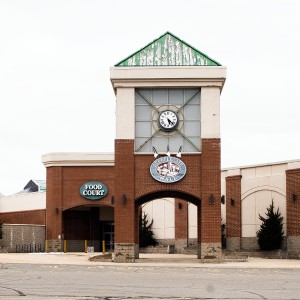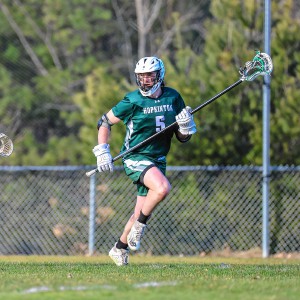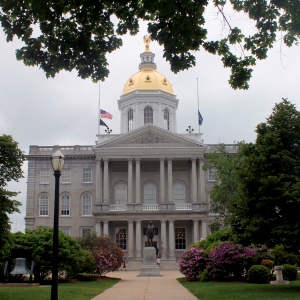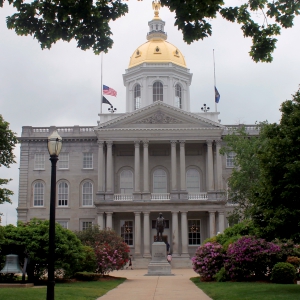Video monitoring to protect NH’s historic covered bridges sees bipartisan support

The Waterloo Covered Bridge in Warner on Feb. 5, 2024. DANA WORMALD / New Hampshire Bulletin
| Published: 02-07-2024 11:47 AM |
After the 1862 Slate Covered Bridge fell victim to arson, Swanzey voters funded the construction of a reproduction in 2001 – one that looked just like it. Today, a sign above its entrance reads, “$5 fine for riding or driving over this bridge faster than a walk.”
Nearly 20 years later, in 2022, Swanzey spent $60,000 to repaint the exterior of another covered bridge in town – the Thompson Bridge, also known as the West Swanzey Bridge.
“Needless to say, covered bridges are important to Swanzey’s history, identity, and sense of community,” Town Administrator Michael Branley told lawmakers last month. “We take their preservation seriously.”
Branley was in Concord testifying in support of House Bill 1217, which would allow the state or a municipality to use video monitoring to identify the cause of damage to historic covered bridges. Proponents of the legislation say drivers who do harm to these cultural landmarks are rarely identified or caught, leaving small towns to pick up the bill.
For privacy reasons, municipalities and the state are prohibited from recording general video of traffic, but there are a few exceptions to the law, such as toll barriers.
Rep. Barry Faulkner, a Swanzey Democrat who lives about a quarter of a mile from a historic covered bridge, seeks to add them to the list of exceptions.
“We have tourists come up every day to take pictures of the bridge,” Faulkner said. “We have busloads of people come up in the fall to see our bridges. It’s an important resource, and I find it disturbing to see the degree of damage. A lot of it is cosmetic, but it’s nonetheless an issue that we all should be concerned about even if we don’t have a bridge in our town.”
Under Faulkner’s bill, such video monitoring could be used only to investigate damage to a covered bridge. All other unrelated footage would be erased after seven days. Faulkner said the legislation is “carefully crafted to respect privacy rights of those who drive through the bridge.”
Article continues after...
Yesterday's Most Read Articles
 Neighboring landowner objection stalls Steeplegate redevelopment approval
Neighboring landowner objection stalls Steeplegate redevelopment approval
 How has Hopkinton, one of the smallest public schools in New Hampshire, become such a lacrosse powerhouse?
How has Hopkinton, one of the smallest public schools in New Hampshire, become such a lacrosse powerhouse?
 In Franklin, a Hometown Hero remains busy, 12 years after retiring from the U.S. Postal Service
In Franklin, a Hometown Hero remains busy, 12 years after retiring from the U.S. Postal Service
 Women at work on Warren: New combined salon, spa, DIY and retail space opens in former Peter’s Images location
Women at work on Warren: New combined salon, spa, DIY and retail space opens in former Peter’s Images location
 For some older Jewish professors at Dartmouth and UNH, opposition to campus arrests feels personal
For some older Jewish professors at Dartmouth and UNH, opposition to campus arrests feels personal
 New Hampshire Harm Reduction Coalition provides kits for safer drug use
New Hampshire Harm Reduction Coalition provides kits for safer drug use
On Feb. 2, an amended version of HB 1217 received unanimous bipartisan support from the House Criminal Justice and Public Safety Committee. As amended, the bill would also require the state to install signs 100 feet away from the covered bridges alerting drivers that they are subject to video surveillance – just as businesses are required to do.
There are approximately 60 remaining covered bridges in New Hampshire, including the longest one in the U.S. – the Cornish-Windsor Bridge, which crosses the Connecticut River and joins New Hampshire and Vermont.
Many of New Hampshire’s covered bridges were built in the mid- to late 1800s. There used to be more than 300 in the state.
In Swanzey, where there are four, a historic covered bridge is part of the town’s seal and letterhead, said Branley, the town’s administrator. Three of those bridges, he testified during a Jan. 19 public hearing, are on rural back roads, meaning drivers who cross them are usually familiar with them.
But the Cresson Bridge, he said, is located on an unnumbered state highway and “one of the few primary routes from Swanzey to the city of Keene.” That bridge carries thousands of vehicles per day, “all too common” of which are those that are too heavy or tall to safely cross the bridge.
“We know how most of them get there,” Branley told lawmakers. “They’re following a GPS, they disregard the warning signs, or just plain aren’t paying attention.”
Faulkner testified that the Cresson Bridge “gets banged up regularly,” noting three separate incidents of damage since last summer.
Rep. Margaret Drye, a Plainfield Republican who has the iconic Cornish-Windsor Bridge located in her district, said HB 1217 is necessary “because a good number of incidents that cause damage to covered bridges are hit and run.”
Faulkner’s bill, on which Drye is a cosponsor, is a companion to one of hers – House Bill 1457 – which would establish penalties for vehicular damage to covered wooden bridges, as well as driving over those bridges in vehicles that exceed posted limits. As written, drivers could face a fine of up to $2,000.
On Feb. 2, ahead of a committee vote on HB 1217, Rep. Jennifer Rhodes, a Winchester Republican, noted a town can lose “a great amount of commerce” if a covered bridge is damaged. For example, in Bucks County, Pennsylvania, it’s estimated that 12 covered bridges attract 8 million visitors annually and generate $1 billion in revenue.
“These bridges are such an important piece to New England’s history, and when people think of New England, they think of these covered bridges,” said Rep. Jonah Wheeler, a Democrat from Peterborough. “(They are) integral to the economy of our state and the tourism of it.”
Back to the newhampshirebulletin.com.







 Bill advances allowing parental opt-outs for LGBTQ+ topics in school
Bill advances allowing parental opt-outs for LGBTQ+ topics in school Transgender sports ban receives Senate committee support
Transgender sports ban receives Senate committee support House passes bill to raise minimum marriage age to 18, sending it to governor
House passes bill to raise minimum marriage age to 18, sending it to governor Charities will not have to pay rent to casinos under new law
Charities will not have to pay rent to casinos under new law
